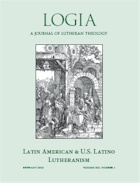 Epiphany 2010, Volume XIX, Number 1Table of Contents
Epiphany 2010, Volume XIX, Number 1Table of Contents
(Introduction by Leo Sanchez)
As a vicar in Caracas, Venezuela, I ventured every so often to one of the largest Roman Catholic bookstores downtown to peruse various collections of dogmatic treatises. On one of my visits, I started a casual conversation with a Venezuelan priest who asked about my background. After learning that I was a Lutheran seminarian, the priest, somewhat perplexed, exclaimed something like, “Latino Lutheran? That is not possible. You cannot be Latino and Lutheran.”
Prior to his ordination into the priesthood, my confounded conversation partner had been a sociologist. Although we did not make time to go a bit more deeply into the topic at hand, I could only imagine how easy it might have been for a sociologist to think of Lutheranism mainly as a German transplant in the Americas, a form of Christianity for a few immigrants of German background, a Protestant movement with no historical or religious roots in the minds and hearts of Latin Americans.
The priest with a sociological streak had not been entirely wrong. If one reads Rudy Blank’s article on Lutheranism in Venezuela, one will find stories of German immigrants or American (meaning South- and North-American) missionaries of German roots establishing Lutheran congregations in predominantly Roman Catholic territory. Some years ago I taught a course at Seminario Concordia in the city of Buenos Aires, Argentina, where I was graciously hosted by pastors with last names like Franck, Fischer, and Meyer. Needless to say, similar stories can be told of the origins of the Lutheran churches in Argentina or Brazil.
Where the Venezuelan priest had not been entirely on target was in his somewhat naive assumption that Spanish Catholicism had overwhelmingly won over the hearts and minds of the evangelized peoples of the Americas. Undoubtedly, after centuries of presence in the Americas, the Roman Catholic Church has defnitely left marks among the people. Doug Rutt’s article points in particular to the image of the dying Christ who suffers along with us — an image with medieval Roman Catholic roots — as the dominant symbol that historically has captivated especially the suffering masses of Latin Americans. However, Rutt also implies that the popular appropriation of the dying Christ by the people, in spite of its accompanying fatalism and not always clear soteriological meaning, has functioned among the masses as a form of silent protest in the face of oppression. By identifying with us in his innocent human suffering, Christ shows his solidarity with those who suffer unjustly.
...read or download the rest of this article here (free, PDF)
...purchase the full journal here
